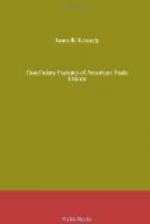The rules of the unions paying sick benefits vary markedly as to the time at which the payment of the benefit begins. The Cigar Makers and the Typographia pay benefits for the first week of sickness but not for a fraction of a week; the benefit begins from the time the sickness is reported to the local union. The Iron Molders and the Boot and Shoe Workers begin payment with the beginning of the second week, and in no case allow benefits for the first week or for a fractional part of a week. In the Pattern Makers’ League, the Brotherhood of Leather Workers on Horse Goods, and the Piano and Organ Workers no benefit is paid unless the illness continues two weeks; the benefits are then paid for the entire period. The Tobacco Workers begin payment with the second week, but if the illness continues twenty-one days, payment is also allowed for the first week. The Plumbers do not pay a sick benefit unless the illness extends two weeks, in which case payment begins with the second week.
The sick benefit is not intended in any of the unions as a pension for persons suffering from chronic disability. In all of them the number of weeks in any one year during which a member may draw the benefit is limited. The usual provision is that the member may not receive the relief more than thirteen weeks in any one year.[146] Several unions, however, set the maximum at eight weeks, while in a very few a member may draw it for more than thirteen weeks in a single year. The most liberal provision is found in the Typographia. A member of that organization may draw a weekly sick benefit of five dollars for fifty weeks, and may then draw a weekly benefit of three dollars for another fifty weeks.
[Footnote 146: See table on page 78.]
Several of the unions have found that certain members draw the maximum number of weeks’ benefit yearly. These members are invalids and practically unable to work at the trade. The benefit is thus to a certain extent converted into a pension for disability. The Iron Molders and the Boot and Shoe Workers have made express provision for retiring such members from the benefit. In 1902 the Iron Molders provided that a member permanently disabled who had “drawn the full sick benefits for three years should be compelled to draw disability benefits.” In 1907 the Financier reported that since 1902 eighty-nine members had thus been retired. In 1906 the Boot and Shoe Workers’ Union provided that after a member had drawn the full amount of the sick benefit for two years he should be paid a disability benefit of one hundred dollars.[147] The Garment Workers reach much the same end by providing that a member may not receive more than eight weeks’ benefit during one year, nor more than twelve in two years, fifteen in three years, and eighteen in four years.[148]
[Footnote 147: Constitution, 1906 (Boston, 1906), pp. 30-32; Proceedings of the Seventh Convention, 1906, pp. 44-45.]
[Footnote 148: Constitution, 1906 (New York, n.d.), p. 41.]




